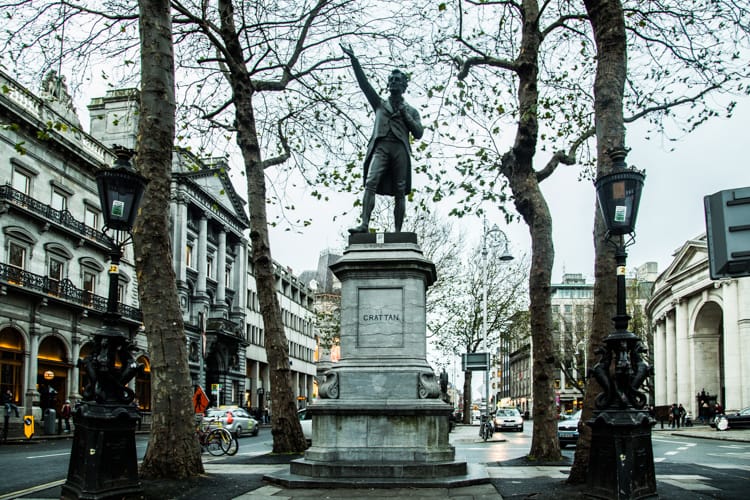What’s the best way to tell area residents about plans for a new asylum shelter nearby?
The government should tell communities directly about plans for new asylum shelters, some activists and politicians say.
When College Green is reordered, where should its statues be moved to? Frank McDonald has some ideas.

Moving statues is not a peculiarly Irish thing to do, even though we’ve probably done it more than most. Where are the statues of King George II that used to be in the middle of St Stephen’s Green, Queen Victoria in front of Leinster House or King William III in College Green? All gone.
The issue arises from plans to reorder College Green, with a great sweeping pavement in front of the old Parliament House that would extend way beyond the present one, and what’s to be done with the statue of Henry Grattan and the Thomas Davis memorial with its retinue of buglers.
A widely publicised computer-generated image of the reordered civic space shows both Henry Grattan and Thomas Davis (minus the fountain and buglers) standing in new positions on the pedestrian plaza in what appears to be a fairly random exercise, almost ignoring the overall context.
The Grattan statue was cast in bronze by Dublin sculptor John Henry Foley, who was also responsible for the triple-tiered O’Connell Monument in O’Connell Street. It was erected in 1876 by Dublin Corporation as a tribute to the great Irish patriot who gave his name to “Grattan’s Parliament”.
Originally surrounded by four ornate street lamps,

of which only two survive, it was positioned facing the main entrance of Trinity College rather than in front of the old Parliament House (now Bank of Ireland). In the 1980s, four London plane trees were planted around it, in another random gesture.
The statue, showing a lifelike Grattan in full flight of oratory, deserves pride of place in the new plaza and should rightfully be positioned in the centre, facing south, with the parliament he led in the background. Crucially, however, the statue should be placed on the axis of the building’s main portico.
As for the Thomas Davis memorial, a rather leaden piece by sculptor Edward Delaney, unveiled by then president Eamon de Valera in 1966, its location in College Green needs more careful consideration. Arguably, it shouldn’t be put back there at all – with or without the troublesome fountain.
For years, gurriers got their kicks by putting Daz or some other washing powder in the fountain, to whip up a storm of soap suds that often went on for days. This presented Dublin City Council with a maintenance nightmare, which is probably why the fountain is not shown in images of the new plaza.
Given the extensive ground plane occupied by the overall Davis memorial (he was a leading figure in the mid-19th-century Young Ireland movement, by the way), it would be better positioned as a new centrepiece for Foster Place, on the axis of the former Central Bank (now the National Wax Museum).
Foster Place, now used as a taxi parking zone, has the potential to become a real oasis, complete with its plane trees, which are to be retained (contrary to a recent now-corrected report in the Irish Times). It once even made the front cover of In Dublin magazine with a French-gingham-covered table in the middle, set for lunch.
That image was quite arresting because it made us think about the use of public spaces in the city. I remember doing a double-take, thinking at first I was looking at a picture of Aix-en-Provence or some other lesser-known French town, until I spotted the front door of the old Central Bank in the background.
Relocating the Davis memorial to Foster Place might seem like a demotion of the patriot, but it’s the only realistic option if the fountain and its buglers are to be retained – as they should be. Not only is it tailor-made to accommodate the memorial, but there would also be a clear view of it from Church Lane.
We have not been good at exploiting axes in Dublin (think of City Hall, off the axis of Parliament Street, for example), but now we have a chance to do so by relocating both Grattan and Davis on the axes of two major public buildings – the old Parliament House and the former Central Bank. It would be a “win-win” outcome.
As sculptures go, the Davis memorial is inferior to Delaney’s Wolfe Tone monument on the north-eastern corner of St Stephen’s Green, with a crescent of rough-hewn granite pillars right behind it. That’s why it was dubbed “Tonehenge” after being unveiled in 1967. The famine memorial to the rear needs restoration, however.
Speaking of statues, when is Thomas Moore’s going to be reinstated on the traffic island at College Street, from where it was removed to facilitate Luas Cross City works? Or Father Matthew in the middle of Upper O’Connell Street, taken down to make room for Luas to cut deep into the central median?
There is one statue that has been relocated really well and should be left where it is. That’s the kitsch buxom representation of Molly Malone and her cart, by Jeanne Rynhart, which originally stood at the bottom of Grafton Street and now stands outside the former St Andrew’s Church. Truly, it looks as if it was always meant to be there.
Get our latest headlines in one of them, and recommendations for things to do in Dublin in the other.